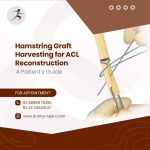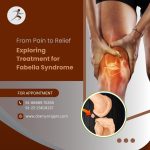Patellar Clunk Syndrome (PCS) is a relatively uncommon but troubling complication that can arise after total knee replacement surgery. It primarily affects patients with posterior-stabilized knee implants, where a polyethylene component is inserted to replace the worn-out cartilage between the femur and tibia. This syndrome is characterized by a painful clicking or clunking sound and sensation in the knee joint during movements, especially while extending the leg. While this condition can be disconcerting for patients, physical therapy often plays a crucial role in addressing and alleviating the symptoms. In this article, we’ll explore how physical therapy can help manage Patellar Clunk Syndrome, its causes, symptoms, and the role of orthopedic specialists in Mumbai in diagnosing and treating the condition.
What is Patellar Clunk Syndrome?
Patellar Clunk Syndrome occurs when a fibrous nodule forms on the posterior aspect of the knee cap (patella) following a total knee replacement surgery. This nodule can get caught in the notch of the femoral component during knee flexion and subsequently release during extension, producing a characteristic "clunk" or "pop."
The syndrome typically presents itself in the early stages following surgery, usually between three to nine months after the procedure. While it is not a dangerous complication, it can cause significant discomfort, pain, and anxiety for patients.
Causes of Patellar Clunk Syndrome
Several factors contribute to the development of PCS, including:
- Excessive Soft Tissue Growth: Post-surgery scar tissue or fibrous growth around the patellar region can lead to the formation of nodules.
- Implant Design: Certain designs of posterior-stabilized knee implants are more likely to cause PCS. These implants typically have a femoral component with a deep groove that can trap the fibrous tissue during flexion.
- Surgical Technique: Suboptimal positioning of the implant or misalignment of the patellar component can increase the likelihood of developing the syndrome.
Knee joint replacement surgeon in Mumbai often work with specialized orthopedic physiotherapists to minimize the risk of PCS by employing the latest surgical techniques and post-operative care protocols.
Symptoms of Patellar Clunk Syndrome
The key symptoms of Patellar Clunk Syndrome include:
- A palpable or audible “clunk” or “pop” during knee extension, particularly when rising from a seated position or straightening the knee after flexion.
- Discomfort or pain in the knee, especially when moving from a flexed to an extended position.
- Occasional swelling or stiffness around the knee.
It’s important to note that the severity of symptoms varies from patient to patient. Some may experience only mild discomfort, while others might struggle with more pronounced pain and reduced mobility.
Diagnosis of Patellar Clunk Syndrome
If you suspect that you are experiencing Patellar Clunk Syndrome after knee replacement surgery, it is essential to consult a qualified knee specialist in Mumbai. The diagnosis typically involves a physical examination, where the orthopedic doctor may palpate the knee joint and evaluate the clunking sensation during movement. Imaging tests, such as X-rays or MRI scans, may also be recommended to rule out other potential complications like implant loosening or mechanical failure.
Role of Physical Therapy in Managing Patellar Clunk Syndrome
Physical therapy is a key component of conservative management for Patellar Clunk Syndrome. In many cases, a tailored rehabilitation program can help patients regain knee function, improve mobility, and reduce the discomfort associated with PCS. Here are some ways in which physical therapy can be beneficial:
-
Strengthening Exercises
Physical therapists focus on strengthening the quadriceps, hamstrings, and calf muscles to provide better support and alignment for the knee joint. Stronger muscles can help reduce the pressure on the patellar tendon, minimizing the likelihood of further irritation of the fibrous nodule.
-
Range of Motion (ROM) Exercises
A crucial aspect of rehabilitation for PCS is restoring full range of motion in the knee joint. Patients with PCS often experience stiffness, which can exacerbate the clunking sensation. ROM exercises help to stretch and mobilize the soft tissues around the knee, reducing stiffness and improving overall knee flexibility.
-
Patellar Mobilization Techniques
Physical therapists may employ manual techniques such as patellar mobilization to gently manipulate the position of the patella and reduce the risk of catching or clunking. This technique is particularly helpful in cases where mild misalignment contributes to the clunk.
-
Scar Tissue Management
Since PCS often stems from excessive scar tissue growth, scar tissue massage or myofascial release techniques can help break down adhesions and reduce the fibrous buildup around the patella. These therapies promote healing and decrease the likelihood of recurrent clunking.
-
Gait Training
Patients who develop PCS may adopt compensatory gait patterns due to discomfort or pain, leading to improper biomechanics and further knee issues. Gait training helps patients relearn proper walking and movement mechanics, reducing unnecessary strain on the knee joint.
-
Pain Management Techniques
Physical therapy also includes modalities to manage pain and inflammation. Cold therapy, ultrasound, electrical stimulation, and other therapeutic interventions may be used to reduce swelling and promote healing.
When is Surgery Necessary?
In cases where conservative management through physical therapy fails to resolve the symptoms, surgical intervention may be required. This typically involves an arthroscopic procedure to remove the fibrous nodule or realign the implant. However, surgery is generally considered a last resort after non-invasive methods have been exhausted.
If you're experiencing persistent symptoms of PCS, consult an experienced knee joint replacement surgeon in Mumbai to determine whether surgical options should be considered.
Why Consult a Knee Specialist in Mumbai?
When dealing with complications like Patellar Clunk Syndrome after knee replacement surgery, it’s crucial to seek care from a specialized orthopedic doctor. Mumbai is home to some of the leading knee specialists and orthopaedic doctors with expertise in joint replacement surgery and post-operative care.
These professionals are not only skilled in performing knee replacement surgeries but also experienced in managing complications such as PCS. They work closely with physical therapists to develop customized rehabilitation plans tailored to each patient’s needs. With a focus on early intervention, they aim to reduce the likelihood of long-term complications and improve patient outcomes.
Conclusion
Patellar Clunk Syndrome can be a frustrating and painful complication for patients who have undergone total knee replacement surgery. However, physical therapy offers an effective, non-invasive solution to alleviate symptoms and restore knee function. With the right rehabilitation program, patients can strengthen their knee, regain full range of motion, and minimize discomfort.
If you suspect you have Patellar Clunk Syndrome or are experiencing knee pain after surgery, it’s essential to seek advice from a knee specialist in Mumbai. Whether through conservative treatment or surgical intervention, early diagnosis and appropriate care can help you achieve a full recovery and return to your daily activities.
If you're looking for guidance from an experienced orthopaedic doctor in Mumbai, contact a local clinic specializing in knee joint replacement surgery to explore your treatment options.
For more information or to book a consultation with Dr. Amyn Rajani, visit OAKS clinic at Hughes Road, Mumbai or website www.dramynrajani.com or simply call on Clinic Number 91-88989 75355 / 91-22-23619137 to take the first step towards a pain-free future.




